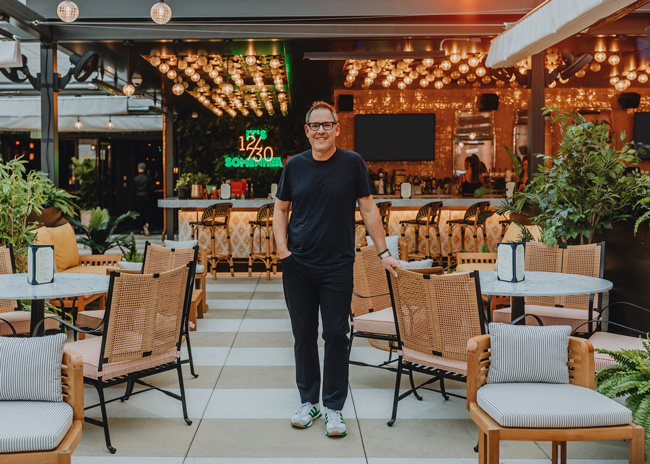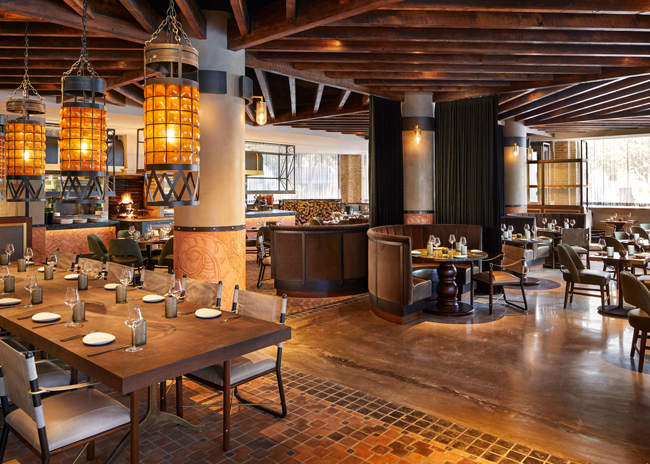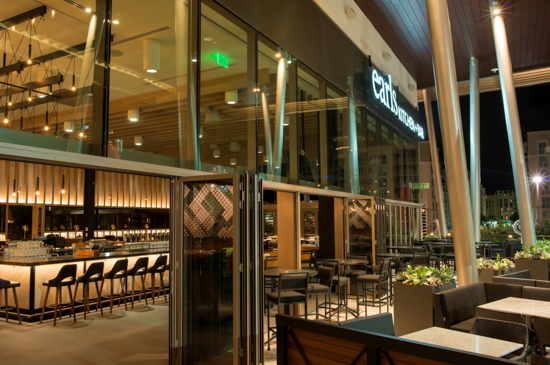Ten years ago, restaurant development + design celebrated its own grand opening, bringing a fresh new editorial concept to market: a magazine we hoped would feel a bit like a communal table or comfortable gathering spot for folks involved in the various aspects of developing, designing and building out restaurants. We wanted rd+d to be an inclusive  Image courtesy of Jack Dustyand engaging platform through which professionals involved in those roles could converse, share best practices, educate, inspire
Image courtesy of Jack Dustyand engaging platform through which professionals involved in those roles could converse, share best practices, educate, inspire
and be inspired.
We’re proud and grateful to be able to say that, for a full decade now, that’s just what our readers have been doing — in the pages of rd+d, on rddmag.com and, as we’ve grown and evolved along with the industry, in webcasts, awards and at events. While we’re firmly focused on continuing to build our industry engagement and enhance rd+d for the next 10 years, we couldn’t let this milestone pass without hitting the archives to gather and share a few highlights, flashbacks, updates and enduring lessons learned.
Most Popular with Readers
From concept trends and construction challenges to leadership insights, how-to advice and, of course, award-winning restaurant designs, rd+d has covered it all and more over the past decade. Here’s a look at some of the stories that drew the greatest interest, at least in terms of clicks on rddmag.com, with our readers through the years.
2012: Development Q&A with Dickey’s Barbecue Pit
Talk about a hot concept. Back in the fall of 2012, when rd+d tapped Richard Phillips, then-VP of Development at Dickey’s Barbecue Pit to discuss Dickey’s development efforts, the chain expected to close out the year with 250 units. Since then, family-owned Dickey’s has grown to become an international, omnichannel franchise organization with nearly 600 units, three virtual brand extensions (Wing Boss, Big Deal Burger, Trailer Birds), e-commerce, meal kits and a thriving branded retail products business.
Sharp insight: Having helped Dickey’s gain strong franchise sales momentum coming out of 2008’s Great Recession, Phillips shared some insights that could resonate in today’s post-pandemic environment:
“This has actually been a good growth environment for us. In tough economic times people are generally more willing and eager to invest in themselves. Many of our franchise owners were at a point in their lives where maybe they had a corporate job or maybe they’ve even been a restaurant manager and were able to save some money. Our marketing as far as franchising sales goes is not geared toward big investment groups and people with millions of dollars. We’re more interested in having people who are willing to invest in themselves and get in and own a restaurant. That, combined with the fact that we’re predominately focused on low-cost conversions, has enabled us to grow quickly.”
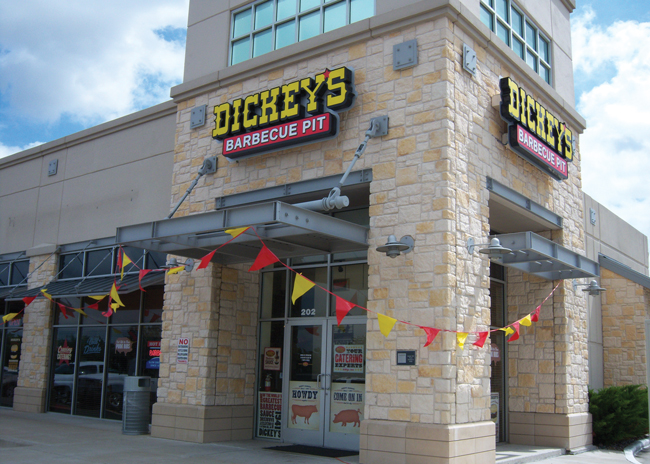 A Q&A with Dickey’s Barbecue Pit’s then-VP of Franchise Development Richard Phillips was the most popular article on rddmag.com in 2012. Image courtesy of Dickey’s Barbecue Pit
A Q&A with Dickey’s Barbecue Pit’s then-VP of Franchise Development Richard Phillips was the most popular article on rddmag.com in 2012. Image courtesy of Dickey’s Barbecue Pit
2015: Zaxby’s Hatches New Prototype
New prototypes are always a subject of interest to rd+d readers, and fast-growing chicken QSR Zaxby’s made a splash in 2015 with its new look. Mirroring a classic red Southern barn on the exterior, complete with distressed brick façade and galvanized tin awnings, interiors were designed to be comfortable, cozy and inviting. Key elements included a mix of seating to appeal to diverse customer groups, warm earth tones, red-washed and exposed brick walls, open wood-beam ceilings, tiled floors resembling wooden planks, Edison bulb lamps and galvanized tin accents to create a farmhouse vibe.
Sharp foresight: Significant ahead-of-the-curve operational enhancements were incorporated. Top among them: a new dual-sided, full cooking and prep suite down the center line of the kitchen, enabling drive-thru prep on one side and in-store dining prep on the other. Such enhancements enabled Zaxby’s to weather the pandemic well and the chain has since kept strong focus on building drive-thru sales. Amy Pritchett, vice president of franchise sales, told rd+d last June that Zaxby’s quick pivot to drive-thru, delivery and curbside pickup was critical to its success over the past couple of years and that the chain is developing another new building prototype focused on drive-thru and delivery.
2017: 10 Kitchen Design Best Practices
There’s a lot to consider when it comes to back-of-house design. This feature laid out kitchen design best practices from start to finish, tapping the expertise of leading design consultants. The topic was also spun off to be one rd+d’s most popular webcasts (still available on-demand to all at rddmag.com/webcasts).
The (brief) bottom line: Define the concept; select the menu; estimate food production needs for projected customer counts; determine service style; select equipment and determine space required for it to function properly; determine staffing requirements; identify utility specs and related space constraints; don’t be stingy with storage space; maximize cold prep space; and designate space for hot bulk prep.
 Zaxby’s 2015 prototype offered significant operational enhancements including a new dual-sided, full cooking and prep suite and a complete interior package overhaul.
Zaxby’s 2015 prototype offered significant operational enhancements including a new dual-sided, full cooking and prep suite and a complete interior package overhaul.
2020: Designing Restaurants in a Post-Pandemic World
In what was nothing short of an apocalyptic year, it’s no surprise that readers in 2020 gravitated to content designed to help them pivot, survive and even thrive under challenging pandemic-induced circumstances. Topics like curbside, drive-thru, third-party delivery, meal kits, contactless transactions, air purification, outdoor dining, plexiglass, ghost kitchens and their collective implications for design quickly rose to the top as immediate priorities shifted.
Among the post-pandemic operational priorities suggested: double make lines and pick-up stations; separate entrances for mobile-order pick-up and dine-in guests; integrated, contactless ordering and digital real estate; highly visible safety and sanitation measures; downsized dine-in; ghost kitchens and virtual brands.
Futuristic insights: While this story appeared early in the pandemic (May/June 2020) designers also shared thoughts on future design implications based on what was happening at the time. A sampling:
- “It doesn’t functionally make sense to make BOH spaces bigger in the sense of social distancing. For example, an extra two steps for a line cook can really harm speed
and efficiency.” —Griz Dwight, GrizForm Design Architects - “We’ll be taking a closer look at the functional aspect of air purification systems, as well as materials and coatings that reduce surface transmission of bacteria and viruses — all of which will become more important.” —Dwayne MacEwen, DMAC Architecture
- “I don’t believe this life is the new normal in the long term. Restaurants won’t necessarily have to rethink how they design to take social distancing into consideration — in fact, quite the opposite. Their protocol will likely be ‘we’re back in action; we need to repack the place with customers and celebrate our inherent yearning for gathering, eating, laughing and socializing.’” —Dave Shove-Brown, //3877
- “This has forced restaurants to expand that market (carryout and delivery) and will lead to design changes — things as simple as building a safe and efficient side entrance, increasing the number of parking stall locations for curbside pickup and implementing double drive-thru lines.” —Matthew Mabie, Knoebel Construction, Inc.
Timeless Tips
Over the years, we’ve been privileged to share insights and expertise from professionals in all aspects of development and design. While some have since moved on to other companies, retired or switched career lanes, their words of wisdom ring as true today as ever.
Site Selection
“There are lots of things you can adjust, but you can’t control your location or your lease/mortgage, which tends to make up about 10% of your revenue. So the most important thing is to find the right location you can afford that can generate the right amount of revenue.” —Alex Diaz, The Restaurant Group, Miami (How To Use Feasibility Reports, 2019)
 When multiconcept operator Sage Restaurant Group looks for locations, it seeks areas with a lot of other restaurants. Along these lines, its Urban Farmer Restaurant is in the Meier & Frank Building next to Portland, Ore.’s bustling Pioneer Square, an iconic part of the city’s downtown culture. From The Art & Science of Site Selection, 2013. Image courtesy of Sage Restaurant Group“Once you qualify the right trade area, then you start looking for a site. The first criterion is to be at the epicenter of the trade area. Good visibility a mile off center is not a good place to be. Even high-end restaurant concepts need visibility and easy access. The need for visibility and an up-front position never goes away.” — Bill McClave, Birchwood Restaurants LLC (The Art & Science of Site Selection, 2013)
When multiconcept operator Sage Restaurant Group looks for locations, it seeks areas with a lot of other restaurants. Along these lines, its Urban Farmer Restaurant is in the Meier & Frank Building next to Portland, Ore.’s bustling Pioneer Square, an iconic part of the city’s downtown culture. From The Art & Science of Site Selection, 2013. Image courtesy of Sage Restaurant Group“Once you qualify the right trade area, then you start looking for a site. The first criterion is to be at the epicenter of the trade area. Good visibility a mile off center is not a good place to be. Even high-end restaurant concepts need visibility and easy access. The need for visibility and an up-front position never goes away.” — Bill McClave, Birchwood Restaurants LLC (The Art & Science of Site Selection, 2013)
“There is no such thing as a standard lease or purchase agreement anymore. Since the recession, everyone has come up with different ways of packaging different ‘delivery conditions’ and the lease work letters no longer contain standard definitions. The changing of two words can impact something that can cost hundreds of thousands of dollars and move it from the landlord’s to the tenant’s responsibility. Additionally, know the value of each of these work letter items and what they truly mean for you.” —Steve Starr, starrdesign (One Problem, Three Solutions: Site Selection, 2018)
“You can’t substitute the emotional intelligence, using your instincts and your gut along with the data, to help a franchisee make a decision…[And] don’t forget your underperformers, because that information is just as valuable because it tells you what you don’t want.” —Larry Sidoti, Garbanzo Mediterranean Fresh (How To Use Digital Analytics for Restaurant Growth, 2019)
 For as much as site selection has changed over the past decade, two things operators historically look for have stayed the same. “The important things for us are location and visibility, although we’re willing to sacrifice some of that for good bones,” says Ed Kane, principal with Boston-based Big Night Entertainment Group (BNEG). BNEG owns and operates high-end restaurants such as The Scorpion Bar, Shrine, Gem and Red Lantern. (From the Art & Science of Site Selection, 2013) Image courtesy of BNEG
For as much as site selection has changed over the past decade, two things operators historically look for have stayed the same. “The important things for us are location and visibility, although we’re willing to sacrifice some of that for good bones,” says Ed Kane, principal with Boston-based Big Night Entertainment Group (BNEG). BNEG owns and operates high-end restaurants such as The Scorpion Bar, Shrine, Gem and Red Lantern. (From the Art & Science of Site Selection, 2013) Image courtesy of BNEG
Construction Cost Savings
“Allowances rarely cover the actual cost of final selections, and these omissions from the drawings force change orders that add to the original budget. On hard bid projects, an architect producing a thorough set of drawings will reduce scope confusion and the need for change orders, thus keeping the budget in check. Fees for architecture and engineering are investments for achieving a predictable project.” —Patrick Kelly, Berkeley Building Company (How To Reduce Change Orders, 2012)
 While many chains now choose analytics, Garbanzo’s Fresh Mediterranean instead strives to emulate what works best at its most successful locations. Important factors include visibility, access, parking and traffic counts. From How to Use Digital Analytics for Restaurant Growth, 2019. Image courtesy of Garbanzo Mediterranean Fresh“Create a value-engineering menu, which translates into a formalized list of potential substitutions compared to the original materials or methods specified, and detail the savings that could be realized. This enables the client to make clear and cost-effective decisions regarding the construction of the project. Architects can also use this list to tailor the project and regularly offer compromises to the client.” —Rob Mescolotto, Hospitality Construction Services (Process-Based Value Engineering Pays Off, 2015)
While many chains now choose analytics, Garbanzo’s Fresh Mediterranean instead strives to emulate what works best at its most successful locations. Important factors include visibility, access, parking and traffic counts. From How to Use Digital Analytics for Restaurant Growth, 2019. Image courtesy of Garbanzo Mediterranean Fresh“Create a value-engineering menu, which translates into a formalized list of potential substitutions compared to the original materials or methods specified, and detail the savings that could be realized. This enables the client to make clear and cost-effective decisions regarding the construction of the project. Architects can also use this list to tailor the project and regularly offer compromises to the client.” —Rob Mescolotto, Hospitality Construction Services (Process-Based Value Engineering Pays Off, 2015)
“The budget is even more important than the timeline. If you go over your budget, it’s going to eat away for years at what you thought you were going to make. The key is to have the correct budget to start. It’s also important to set aside funds, around 10% of the job cost, to deal with unanticipated budget overages.” —Tim Spiegelglass, Spiegelglass Construction Company (Construction Control: 5 Challenges of Building a Restaurant, 2019)
“With all the different levels of service you can purchase from your designers, it’s tempting to go cheap. Be careful of going too cheap, though. I’ve seen owners shell out tens of thousands of dollars to correct mistakes that could have been avoided by paying for an extra site visit or additional sketches.” —Joe Crowley, Trinity Building + Construction Management (Tips for Successful Restaurant Construction, 2018)
Then, Now & Next: Designer Insights
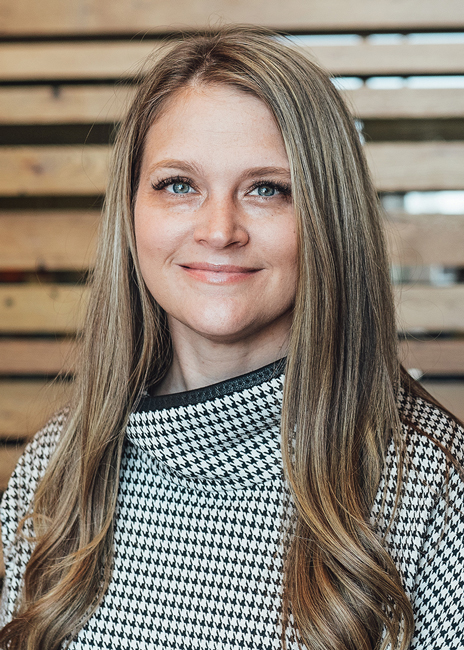 Nicole PooleDesigner Nicole Poole first appeared in the pages of rd+d back in 2014 as part the magazine’s inaugural Designers Dish! roundtable panel. Then a project designer with Chicago-based Aria Group Architects, Poole recently became Hospitality & Design Lead at HFA, a design, architecture and engineering firm headquartered in Bentonville, Ark. We checked back in with her for some quick insights on then versus now, and what’s next.
Nicole PooleDesigner Nicole Poole first appeared in the pages of rd+d back in 2014 as part the magazine’s inaugural Designers Dish! roundtable panel. Then a project designer with Chicago-based Aria Group Architects, Poole recently became Hospitality & Design Lead at HFA, a design, architecture and engineering firm headquartered in Bentonville, Ark. We checked back in with her for some quick insights on then versus now, and what’s next.
Ten years ago, the big buzz in restaurant materials/finishes seemed to be all around reclaimed wood and Edison bulbs. Still relevant, or have new “it” items grabbed the spotlight?
NP: Trends always seem to make their way back around; it just takes time. Edison bulbs may not be the latest trend anymore, so they’re not included in new designs as much. But we are seeing hunter green and burgundy making a comeback in new product color options, a clear flashback to the ’90s.
Over the past decade, what aspect of restaurant design has become more challenging?
NP: Incorporating more digital elements into the space without them taking over the concept. One example is self-service stations or kiosks, which can make an impact on the design and how it evolves based on flow.
 While working with Aria Group Architects, Nicole Poole designed One Fifty One restaurant in Elmhurst, Ill., which was featured in 6 Ways to Get Expensive Looks for Less, 2017. Images courtesy of Emilia Czader
While working with Aria Group Architects, Nicole Poole designed One Fifty One restaurant in Elmhurst, Ill., which was featured in 6 Ways to Get Expensive Looks for Less, 2017. Images courtesy of Emilia Czader
What’s one design element that clients are asking for today that wasn’t in demand a decade ago?
NP: For our fast-casual spaces, we see a greater demand for third-party delivery and pick-up areas, which we didn’t see a decade ago. The same goes for quick-service drive-thru-only concepts and ghost kitchens.
What’s changed the most in terms of how design teams’ work gets done now versus then?
NP: In the past few years we’ve seen a major shift in our overall team environment. We’re no longer looking just for local talent, but instead for professionals who could be working from anywhere. It’s become more about finding ways to be creative on a digital platform.
What’s one emerging design or development trend you feel will become increasingly important as we look toward the next 10 years?
NP: Restaurants will continue to evolve, and trends will come and go as they always have, but one thing that will remain consistent and important is providing a great end-user dining experience.

